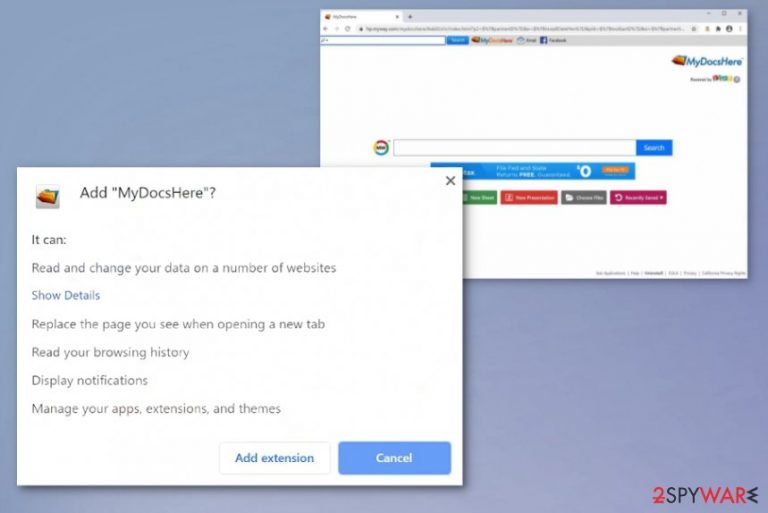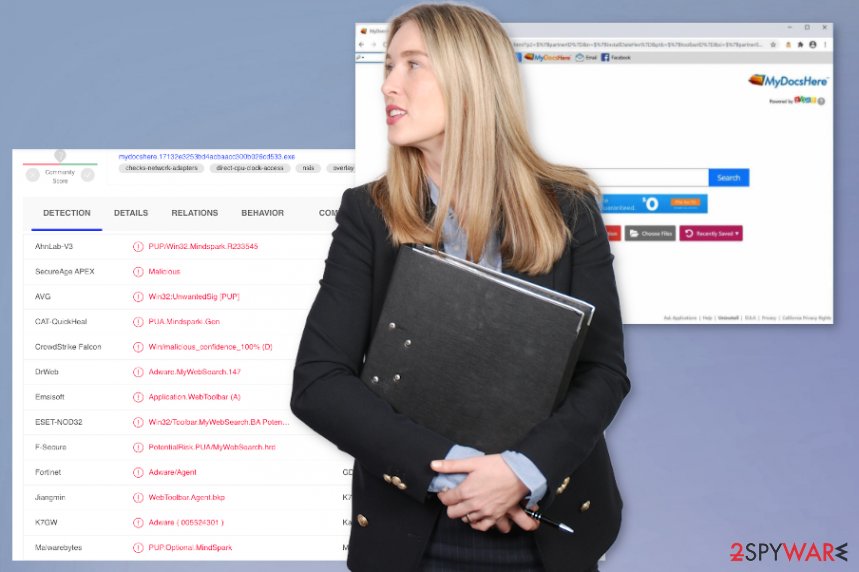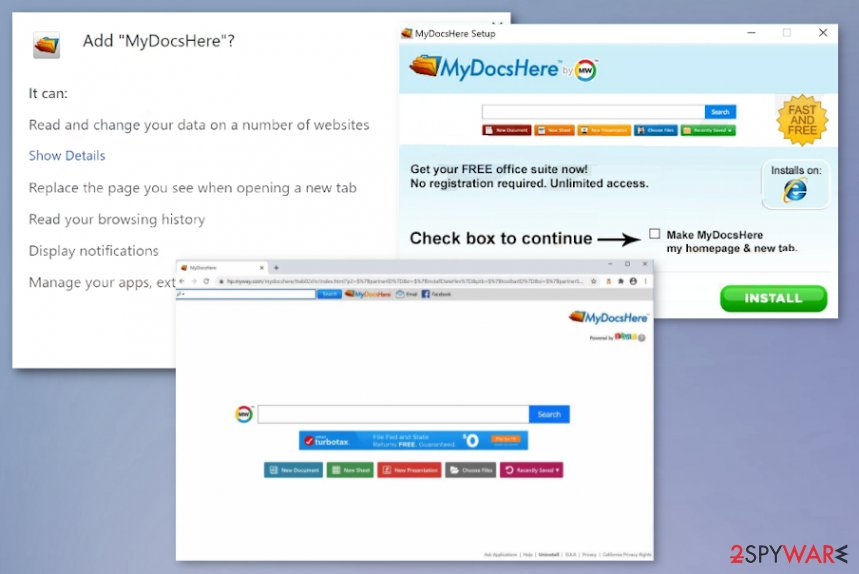MyDocsHere (Free Guide) - Removal Instructions
MyDocsHere Removal Guide
What is MyDocsHere?
MyDocsHere is the hijacker that creates issues with browsing online when unwanted content starts coming to the screen out of nowhere

Users claim that MyDocsHere virus is malicious because it mainly appears out of nowhere and provides nothing but annoying features. This potentially unwanted program aims to affect your browsing experience and cause redirects, so views can be monetized, and sponsors make a profit. There is nothing that could be valuable about this application, especially when it is related to Hp.myway.com.
| Name | MyDocsHere |
|---|---|
| Type | Browser hijacker[1] |
| Distribution | Freeware installations include the toolbar or PUP itself as additional download and trigger the infection when the person ins not paying enough attention to details during the process |
| Issues | The program itself runs in the background, so it can trigger issues with the system and expose the user to third-party content, malicious sites when advertisements trigger all the reroutes to shady domains |
| Elimination | MyDocsHere removal – a process that requires attention to details since PUP can install various files and programs behind your back |
| Repair | Restore functions and programs that got affected by running FortectIntego on the machine |
MyDocsHere is the program that controls your web browser search queries and tries to cause redirects to advertising pages, make a difference in speed and performance of the computer. This program can freely affect mobile devices too. If that happens, it is even more difficult to get rid of all the pop-ups and content related to the intruder.
When you encounter any pop-ups, banners, MyDocsHere ads, or even additional installs of browser applications, toolbars, you need to take all these issues seriously and take care of the system immediately. The first indication that the machine is infected by the potentially unwanted program is the difference noticed in speed and performance of the device.
If you receive messages from unknown pages, suffer from speed issues, and also see MyDocsHere Toolbar added on the machine, check for dangerous applications as soon as possible. If you manage to find the PUP that triggers all the changes soon enough, you can get rid of it with proper anti-malware tools yourself.

If you find the installation of MyDocsHere virus already triggered and encounter all those web browser alterations, changes in default settings, and so on, you need to get a proper tool and remove the PUP. The best way to find a trustworthy AV is to base your selection on the malicious detection rate.[2]
MyDocsHere removal can take some time if you try to find ally he associated files and programs yourself. It is not the recommended method because PUPs might install other files and programs on the machine, so you have a difficult time. You need to repair those corrupted files too. So follow steps below, and do what experts[3] often talk about repair the damage.
Remember that MyDocsHere adds various changes to the machine, especially on your web browsing tools, so you should take care of the traces if you want to keep the privacy and security of your data. Your information can be recorded, attacked, and even shared with third-parties.
You can fully remove MyDocsHere with anti-malware tools or security programs that are designed to find anything suspicious or malicious, but the damage that virus or unwanted application is leaving behind is not fixed that way. You can recover system parts using a tool like FortectIntego, so run the app and fix affected files.

Software installers have shady purposes to distribute PUPs
The way that PUP developers use so they can spread their products around quickly is software installers and third-party sites that deceive people and mislead them. The reputable program installed and popular programs get distributed online, but virus-code or just a useless tool gets included.
Performance-enhancing programs also can be distributed via promotional sites and advertising domains, so you fall for the trick without knowledge. If you choose proper methods during the installation, you can control the additional downloads. You need to always fo for Advanced or Custom options for that.
Clear the system by eliminating all the traces of MyDocsHere virus
The system that is affected by the shady PUP cannot be considered safe. You need to remove MyDocsHere and do that as soon as you notice any pop-ups, banners, or different tools installed on the browser, directly on the computer.
It is important because the sooner you start the MyDocsHere removal, the quicker you clear all the traces and shady programs related to the PUP. There are many files and registry entries that can control the persistence and keep you from cleaning the machine properly.
You may remove virus damage with a help of FortectIntego. SpyHunter 5Combo Cleaner and Malwarebytes are recommended to detect potentially unwanted programs and viruses with all their files and registry entries that are related to them.
Getting rid of MyDocsHere. Follow these steps
Uninstall from Windows
Remove MyDocsHere from the machine, so you can use the computer normally again
Instructions for Windows 10/8 machines:
- Enter Control Panel into Windows search box and hit Enter or click on the search result.
- Under Programs, select Uninstall a program.

- From the list, find the entry of the suspicious program.
- Right-click on the application and select Uninstall.
- If User Account Control shows up, click Yes.
- Wait till uninstallation process is complete and click OK.

If you are Windows 7/XP user, proceed with the following instructions:
- Click on Windows Start > Control Panel located on the right pane (if you are Windows XP user, click on Add/Remove Programs).
- In Control Panel, select Programs > Uninstall a program.

- Pick the unwanted application by clicking on it once.
- At the top, click Uninstall/Change.
- In the confirmation prompt, pick Yes.
- Click OK once the removal process is finished.
Delete from macOS
Remove items from Applications folder:
- From the menu bar, select Go > Applications.
- In the Applications folder, look for all related entries.
- Click on the app and drag it to Trash (or right-click and pick Move to Trash)

To fully remove an unwanted app, you need to access Application Support, LaunchAgents, and LaunchDaemons folders and delete relevant files:
- Select Go > Go to Folder.
- Enter /Library/Application Support and click Go or press Enter.
- In the Application Support folder, look for any dubious entries and then delete them.
- Now enter /Library/LaunchAgents and /Library/LaunchDaemons folders the same way and terminate all the related .plist files.

Remove from Microsoft Edge
Delete unwanted extensions from MS Edge:
- Select Menu (three horizontal dots at the top-right of the browser window) and pick Extensions.
- From the list, pick the extension and click on the Gear icon.
- Click on Uninstall at the bottom.

Clear cookies and other browser data:
- Click on the Menu (three horizontal dots at the top-right of the browser window) and select Privacy & security.
- Under Clear browsing data, pick Choose what to clear.
- Select everything (apart from passwords, although you might want to include Media licenses as well, if applicable) and click on Clear.

Restore new tab and homepage settings:
- Click the menu icon and choose Settings.
- Then find On startup section.
- Click Disable if you found any suspicious domain.
Reset MS Edge if the above steps did not work:
- Press on Ctrl + Shift + Esc to open Task Manager.
- Click on More details arrow at the bottom of the window.
- Select Details tab.
- Now scroll down and locate every entry with Microsoft Edge name in it. Right-click on each of them and select End Task to stop MS Edge from running.

If this solution failed to help you, you need to use an advanced Edge reset method. Note that you need to backup your data before proceeding.
- Find the following folder on your computer: C:\\Users\\%username%\\AppData\\Local\\Packages\\Microsoft.MicrosoftEdge_8wekyb3d8bbwe.
- Press Ctrl + A on your keyboard to select all folders.
- Right-click on them and pick Delete

- Now right-click on the Start button and pick Windows PowerShell (Admin).
- When the new window opens, copy and paste the following command, and then press Enter:
Get-AppXPackage -AllUsers -Name Microsoft.MicrosoftEdge | Foreach {Add-AppxPackage -DisableDevelopmentMode -Register “$($_.InstallLocation)\\AppXManifest.xml” -Verbose

Instructions for Chromium-based Edge
Delete extensions from MS Edge (Chromium):
- Open Edge and click select Settings > Extensions.
- Delete unwanted extensions by clicking Remove.

Clear cache and site data:
- Click on Menu and go to Settings.
- Select Privacy, search and services.
- Under Clear browsing data, pick Choose what to clear.
- Under Time range, pick All time.
- Select Clear now.

Reset Chromium-based MS Edge:
- Click on Menu and select Settings.
- On the left side, pick Reset settings.
- Select Restore settings to their default values.
- Confirm with Reset.

Remove from Mozilla Firefox (FF)
Remove dangerous extensions:
- Open Mozilla Firefox browser and click on the Menu (three horizontal lines at the top-right of the window).
- Select Add-ons.
- In here, select unwanted plugin and click Remove.

Reset the homepage:
- Click three horizontal lines at the top right corner to open the menu.
- Choose Options.
- Under Home options, enter your preferred site that will open every time you newly open the Mozilla Firefox.
Clear cookies and site data:
- Click Menu and pick Settings.
- Go to Privacy & Security section.
- Scroll down to locate Cookies and Site Data.
- Click on Clear Data…
- Select Cookies and Site Data, as well as Cached Web Content and press Clear.

Reset Mozilla Firefox
If clearing the browser as explained above did not help, reset Mozilla Firefox:
- Open Mozilla Firefox browser and click the Menu.
- Go to Help and then choose Troubleshooting Information.

- Under Give Firefox a tune up section, click on Refresh Firefox…
- Once the pop-up shows up, confirm the action by pressing on Refresh Firefox.

Remove from Google Chrome
Make sure to clear the browser properly, so the toolbar or any application related to MyDocsHere is uninstalled
Delete malicious extensions from Google Chrome:
- Open Google Chrome, click on the Menu (three vertical dots at the top-right corner) and select More tools > Extensions.
- In the newly opened window, you will see all the installed extensions. Uninstall all the suspicious plugins that might be related to the unwanted program by clicking Remove.

Clear cache and web data from Chrome:
- Click on Menu and pick Settings.
- Under Privacy and security, select Clear browsing data.
- Select Browsing history, Cookies and other site data, as well as Cached images and files.
- Click Clear data.

Change your homepage:
- Click menu and choose Settings.
- Look for a suspicious site in the On startup section.
- Click on Open a specific or set of pages and click on three dots to find the Remove option.
Reset Google Chrome:
If the previous methods did not help you, reset Google Chrome to eliminate all the unwanted components:
- Click on Menu and select Settings.
- In the Settings, scroll down and click Advanced.
- Scroll down and locate Reset and clean up section.
- Now click Restore settings to their original defaults.
- Confirm with Reset settings.

Delete from Safari
Remove unwanted extensions from Safari:
- Click Safari > Preferences…
- In the new window, pick Extensions.
- Select the unwanted extension and select Uninstall.

Clear cookies and other website data from Safari:
- Click Safari > Clear History…
- From the drop-down menu under Clear, pick all history.
- Confirm with Clear History.

Reset Safari if the above-mentioned steps did not help you:
- Click Safari > Preferences…
- Go to Advanced tab.
- Tick the Show Develop menu in menu bar.
- From the menu bar, click Develop, and then select Empty Caches.

After uninstalling this potentially unwanted program (PUP) and fixing each of your web browsers, we recommend you to scan your PC system with a reputable anti-spyware. This will help you to get rid of MyDocsHere registry traces and will also identify related parasites or possible malware infections on your computer. For that you can use our top-rated malware remover: FortectIntego, SpyHunter 5Combo Cleaner or Malwarebytes.
How to prevent from getting browser hijacker
Stream videos without limitations, no matter where you are
There are multiple parties that could find out almost anything about you by checking your online activity. While this is highly unlikely, advertisers and tech companies are constantly tracking you online. The first step to privacy should be a secure browser that focuses on tracker reduction to a minimum.
Even if you employ a secure browser, you will not be able to access websites that are restricted due to local government laws or other reasons. In other words, you may not be able to stream Disney+ or US-based Netflix in some countries. To bypass these restrictions, you can employ a powerful Private Internet Access VPN, which provides dedicated servers for torrenting and streaming, not slowing you down in the process.
Data backups are important – recover your lost files
Ransomware is one of the biggest threats to personal data. Once it is executed on a machine, it launches a sophisticated encryption algorithm that locks all your files, although it does not destroy them. The most common misconception is that anti-malware software can return files to their previous states. This is not true, however, and data remains locked after the malicious payload is deleted.
While regular data backups are the only secure method to recover your files after a ransomware attack, tools such as Data Recovery Pro can also be effective and restore at least some of your lost data.
- ^ Browser hijacker. Wikipedia. The free encyclopedia.
- ^ Malware detection rate. VirusTotal. Online malware scanner.
- ^ Virusai. Virusai. Spyware related news.
